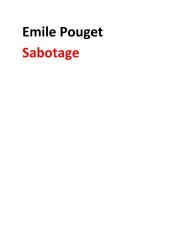o_195qg5dto17o4rbc85q1ge61i84a.pdf
Create successful ePaper yourself
Turn your PDF publications into a flip-book with our unique Google optimized e-Paper software.
150<br />
anarchism: a beginner’s guide<br />
argues, it describes an act intended to present ‘a partial or temporary<br />
solution to a larger set of practices’. David Wieck offers this definition:<br />
If a butcher weighs one’s meat with his thumb on the scale, one may<br />
complain about it and tell him he is a bandit who robs the poor, and<br />
if he persists and one does nothing else, this is mere talk; one may<br />
call the Department of Weights and Measures, and this is indirect<br />
action; or one may, talk failing, insist on weighing one’s own meat,<br />
bring along a scale to check the butcher’s weight, take one’s business<br />
somewhere else, help open a co-operative store, etc., and these are<br />
direct actions. 60<br />
Direct action is often associated with illegality and sometimes<br />
criminality. Since the nineteenth century anarchists have been<br />
known to support acts of simple theft – not only in the shape of<br />
fare dodging, but in the guise of bank robbery and shoplifting – as a<br />
legitimate part of anarchist campaigning. To the distress of<br />
anarchists like Guérin, the Bonnot Gang (usually credited with<br />
having thought of the idea of the getaway car before Bonnie and<br />
Clyde) firmly linked French anarchism to banditry. In Australia, the<br />
outlaw Ned Kelly achieved a similar feat, now often celebrated as a<br />
progenitor of homegrown anarchism. Yet because direct action is<br />
designed to solve a problem and because anarchists have difficulty<br />
showing how mere criminality fits this bill, it usually has an overtly<br />
‘political’ character, even if it is illegal.<br />
Whilst direct actions are intended to move beyond symbolism,<br />
they may have a symbolic element. To give an example: in the 1960s<br />
anarchist anti-Francoists used small bomb attacks in their<br />
campaigns. Their actions symbolized a desire to topple the regime,<br />
but were intended to have a direct effect on would-be holiday-makers,<br />
creating fear whilst avoiding harm, and on the tourist industry that<br />
helped legitimize Franco’s rule. Squatting is probably the bestknown<br />
and most widely practised form of direct action, and one that<br />
anarchists are keen to encourage. Squatting can be used to further<br />
experiments in community living and as a form of protest. In the<br />
first sense, it is a form of practical anarchy, associated both with the<br />
problem of homelessness and the creation of alternative forms of<br />
community – co-operatives or, more recently, co-housing projects,<br />
where groups of people living in private residences share kitchen,<br />
laundry, workshop and child care facilities. As a form of protest<br />
squatting has recently been used by eco-anarchists. One example




